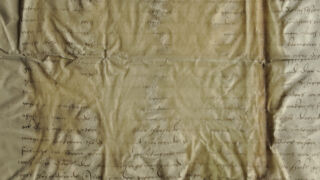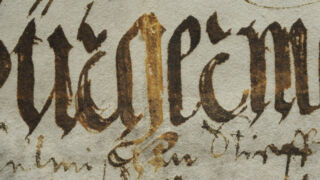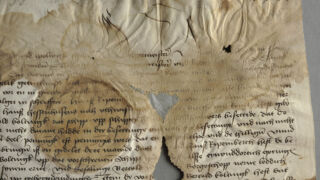C 6.5. Ink loss; fading
C6 damage sub-categories:
C 6.1. Rust accretion, foxing
C 6.2. Glass-like layers
C 6.3. Stains, accretion
C 6.3.1. Handling marks
C 6.3.2. Ink stains
C 6.4. Ink corrosion
C 6.5. Ink loss; fading
C 6.6. Offset
C 6.7. Ink flake off; detachment of the parchment
C 6.8. Tears, splits
C 6.9. Pleats
C 6.10. Cockling
C 6.11. Curling
C 6.12. Pleats, double folds
C 6.13. Folds
C 6.14. Contraction, shrinkage
C 6.15. Internal loss
C 6.16. Edge loss
C 6.17. Blooms; calcite deposits
C 6.18. Micro-biological damage, mould, grazing
C 6.19. Brittleness
C 6.20. Rigidity, stiffness
For documentation, the mechanical losses of the manuscript text that occur during handling, and the wear or loss of text in the damaged parts of parchment are defined as ink losses. The fading of the writing and decrease in the colour intensity are described as fading. In both bases the legibility of the manuscript decreases.
Ink loss can be caused by stains on the text, mechanical wear and damage to the parchment surface, or the text being written on an uneven surface. Fading is a partial or extensive lightening of the ink that is visible to the eye, which can make the writing difficult to read. Situations may occur where ink loss and fading occur simultaneously.

Ürik TLA.230.1.be_14/v,1503. a.

Ürik TLA.230.1.be_14/v,1503. a.
Tindikadu. Luitumine, valastumine.
Meediumi luitumist ja värvuse intensiivsuse vähenemist kirjeldatakse valastumisena.

Tindikadu. Luitumine, valastumine.
Meediumi luitumist ja värvuse intensiivsuse vähenemist kirjeldatakse valastumisena. Mõlemal juhul on tegemist käsikirja loetavuse halvenemisega.
Tindi(meediumi) valastumine plekkidega degradeerunud pärgamendil

Ürik TLA.230.1-ii.220, 1508. a. </ Seisund 3.
Tindikadu. Luitumine, valastumine.
Tindi värvuse intensiivsuse vähenemine algjärgus.
.

Ürik TLA.230.1-ii.220, 1508. a.
Tindikadu. Luitumine, valastumine.
Tindi värvuse intensiivsuse vähenemine algjärgus.

Ürik TLA.230.1-ii.82, 1466. a.
Tindikadu. Luitumine, valastumine.
Esineb kahjustumise põhjuseid, mille puhul tindikadu ja valastumine võivad esineda koos.
Tindikirja valastumine tugt degradeerunud ja üleni klaasjate aladega ja plekkidega kaetud ürikul.

Ürik AM.115.2.1, 1647. a.
Tindikadu. Luitumine, valastumine. Tindi mehaaniline kadu käsitsemise või kulumise tulemusena Tindi värvuse intensiivsuse vähenemine piki dokumendi murdejoont. Tindikadu on põhjustatud dokumendi käsitsemisest.
Tindikadu. Luitumine, valastumine. Tindi mehaaniline kadu käsitsemise või kulumise tulemusena Tindi värvuse intensiivsuse vähenemine piki dokumendi murdejoont. Tindikadu on põhjustatud dokumendi käsitsemisest.

Ürik AM.115.2.1, 1647. a.
Tindikadu. Luitumine, valastumine.
Tindi värvuse vähenemine mehaanilise kulumise tagajärjel. Tindikadu piki dokumendi murdejoont.

